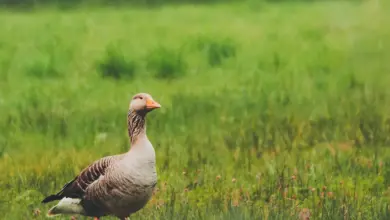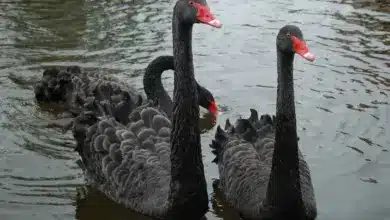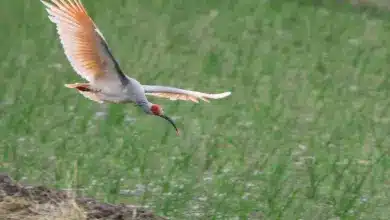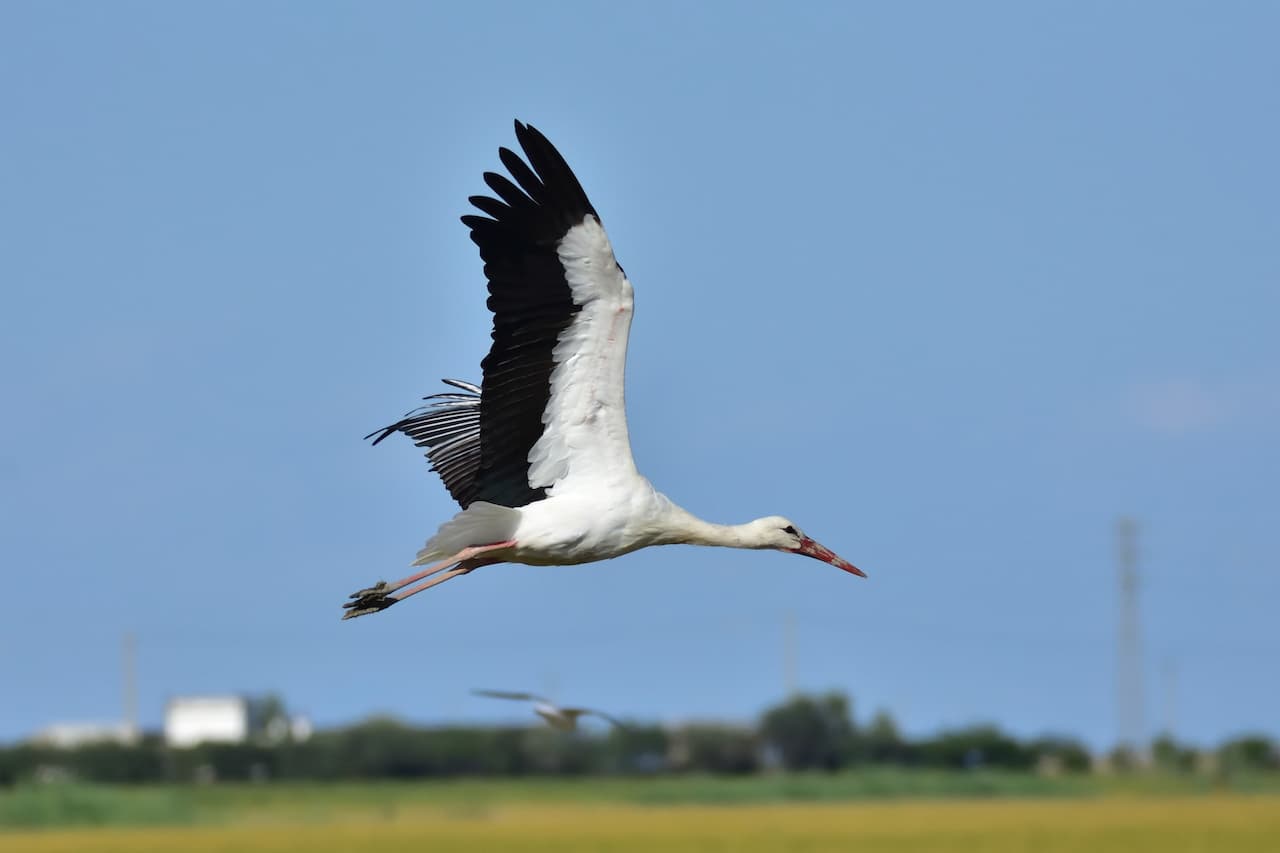Aleutian Cackling Geese
The Aleutian Cackling Geese or Tundra Goose (Branta hutchinsii leucopareia) – formerly known as the Aleutian Canada Goose (Branta canadensis leucopareia) – is a small subspecies of Cackling Goose.
Some authorities consider it a subspecies of the Small Cackling Goose (Branta hutchinsii minima) or the extinct Bering Cackling Goose (Branta hutchinsii asiatica).
They were named for their former home range – the Aleutian Islands situated in the Northern Pacific Ocean, westward from the Alaska Peninsula. This species was considered extinct until a colony was discovered on Buldir Island in 1962. They are now mostly found in wildlife refuges.
This goose is easily recognized by its black head and neck, distinctive white patches on the face, light tan to cream chest, and its otherwise brownish-grey plumage.
They are strong swimmers, divers, and flyers.
The male is referred to as “gander,” the female as “goose,” and the chicks are called goslings. A flock of geese on the ground is known as a gaggle. Geese flying in the typical v-formation are referred to as “wedge” or skein.”

Alternate (Global) Names
Danish: Aleutisk Canadagås … Dutch: Alaskagans, Aleoeten canada gans … German: Aleuten Zwergkanadagans … French: Bernache d’Aleuten, Bernache de Hutchins (Aléoutiennes), Bernache de Hutchins (forme des Aléoutiennes), Bernache des Aléoutiennes … Polish: bernikla aleucka … Russian: ??????? ????????? ????????? … Spanish: Ganso canadiense

Description
The Aleutian Cackling Goose is a small goose that is only slightly larger than a mallard duck and weighs typically between 3.7 – 4.6 lbs (1.7 – 2.1 kg).
The plumage is mostly greyish brown, except for the black head and neck, white cheek patches that run under its chin like a strap (commonly referred to as “chin straps”), black tail feathers, white rump, and light tan to brown chest (although a small number of darker chested birds occur).
The adult Aleutian Cackling Goose can be distinguished from its relatives by the conspicuous white neck ring at the base of the neck that is usually 0.5 inches (12.7 millimeters) in width or wider.
The webbed feet and wide, flat bill are black. The bill has lamellae (miniature ridges inside the bills of water-feeding birds or “teeth”) around the outside edges of the bill that are used as a cutting tool.
In flight, their large, dark wings can be seen, and possibly a U-shaped white rump and white under-tail feathers.
The westernmost population did not appreciably differ in color, except that the neck ring was always very wide and white in the few attested specimens.
Similar Species
Resembles the Small Cackling Goose (B. h. minima) which is smaller in size and has a dark breast color with a purplish or brownish cast.
The Taverner’s Cackling Geese (B. h. taverneri) are larger and have a lighter breast color.
Both minima and taverneri may occasionally have white neck rings, but these are usually narrow or indistinct.
Male / Female Identification
Males and females look alike, although females are usually a little smaller than males and have different voices.
Juveniles
Immature birds have a duller head and neck coloration.
Yearly Molt
Late June to mid-July (during the breeding season), these geese undergo a complete simultaneous replacement of all their flight feathers, which leaves them unable to fly for about a month (until the new flight feathers have grown in). During this time, these birds are particularly vulnerable to predation. In anticipation of this vulnerability, they generally move to a safe area prior to this molt – typically near water with readily available food and an unobstructed view of predators or danger. Their new flight feathers grow back in time for their migration back to their wintering territories.
Non-breeding juveniles, non-nesting adults, and adults whose nests have been destroyed are usually the first ones to undergo this molt, and breeding pairs follow.
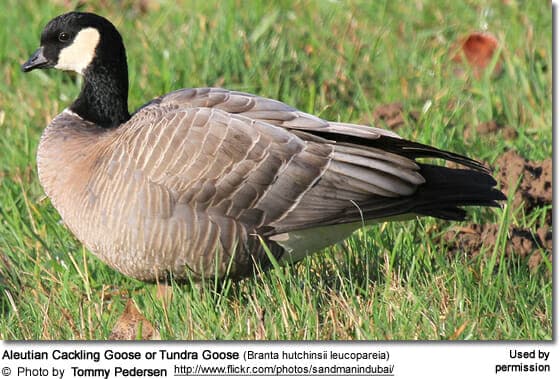
Distribution
The Aleutian Cackling Geese formerly occurred throughout the Aleutian Islands situated in the Northern Pacific Ocean, westward from the Alaska Peninsula.
Their wintering range is located in California, near Modesto where they primarily occur on two privately owned ranches and on the adjacent San Joaquin River National Wildlife Refuge.
Behavior
Cackling Geese are highly social creatures and – outside the breeding season – are usually seen in groups.
During the breeding season in particular, male Cackling Geese can be very aggressive towards intruders or predators, including readily attacking humans that get too close to their nests or young.
They also defend their territories against other (unfamiliar) geese, grabbing each other’s chest with their beaks and landing blows with their wings.
These attacks are typically preceded by them lowering their heads to the ground with the beak open, pumping the head up and down, and making hissing sounds.
When charged against humans, they usually stand erect, spreading their wings and producing a hissing sound followed by the attack, which usually involves biting and wing flapping.
Breeding / Nesting
Cackling Geese reach reproductive maturity when they are about 2 years old, and their first nesting usually occurs during the spring-summer of their third year. They usually find their mates during the second year of their lives.
Cackling Geese tend to choose mates that are similar in size (“assortative mating”) and typically mate for life. However, if one perishes, the other will select a new mate.
Most nesting activities are observed between April and June.
Aleutian Cackling Geese typically nest on south-facing turf slopes above rocky shorelines. They typically return to the same general nesting site year after year.
The female builds the nest, a shallow bowl with a slight depression in the center. The nest is made of sticks, grasses, reeds, and weeds, and lined with down feathers plucked from the female’s chest and soft plant material.
Both the male and female defend the nest before egg laying and after the eggs have been laid, the male alone defends the nest while the female incubates the eggs. They usually only produce one brood a year, but if a clutch is destroyed, may start on a second.
A clutch can consist of 2 – 8 creamy-white eggs (mostly 4 – 6). Eggs are laid every one and a half days apart. Only after a clutch is complete will the female commence incubation, which lasts about 24 – 28 days to hatching. While brooding the eggs, the female turns the eggs over often as is necessary for optimum development of the embryo. (Eycleshymer, 1907: New, 1957; Robertson, 1961a; Deeming, 1989). The hatching chicks break out of the shell by using an “egg tooth” – a hard growth on top of their beaks, which diminishes not long after hatching. It may take 8 – 36 hours for them to completely break out of the shell (French and Parkhurst, 2001).
The hatchlings are covered in down and their eyes are open. They are able to walk, swim, dive, and feed themselves within 1 – 2 days after hatching. At this point, the goslings are led to feeding areas by their parents.
The parents are seen leading their young in a line – usually with one parent at the front and the other at the back.
The parents will protect their young, first warning intruders/predators with a hissing sound and then chasing them away. When the young are 7 – 10 weeks old (depending on the subspecies), the goslings are self-supporting and capable of sustained flight. However, the young usually remain with their parents until after the spring migration – when they return to their birthplace.
Goslings from several family broods may form “gang broods” – and these groups may contain up to 100 goslings.
During the incubation period, the adults lose their flight feathers and can’t until after the chicks hatch.
Calls / Vocalizations
Cackling Geese are usually very vocal and are known for their deep “honking” calls – often heard in flight.
They make hissing sounds when threatened.
Lifespan and Predation
Cackling Geese in the wild can live 10 – 25 years. Captive birds that are well taken care of could possibly live to 35 or even 40 years. .
The primary threat to the Aleutian Cackling Goose has been predation by Arctic Foxes that were introduced to the Aleutian Islands by Russian fur traders between 1836 and 1930.
Adults are most often injured or killed by human hunters.
Diseases / Health Problems
Common diseases of the Aleutian Cackling Geese include avian cholera, avian botulism, avian salmonellosis, chlamydiosis, duck plague (or duck virus enteritis, DVE), aspergillosis, and gizzard worms.
The spread of disease is facilitated in resident (non-migratory) goose populations or large congregations of birds where these geese come in close contact with each other
Many succumb from heavy metal poisoning – picked up from contaminated mining sites, but also caused by the ingestion of lead shots during the hunting season and lead fishing weights).
Further Goose Information
- Goose Information / Overview
- Photos of the Different Goose Species for Identification
- Species Index of Geese
Diet / Feeding
Aleutian Cackling Geese are mostly herbivores – feeding on green vegetation (including a variety of grasses, pondweed, clover, cattails, bulrushes, and algae), grains, and berries (if available) found in shallows, marshes, and fields.
Sometimes they will also eat small insects, fish, small crustaceans, and mollusks that are attached to aquatic vegetation – particularly when breeding or feeding young, as they need more protein in their diet for their development.
On land, they graze while walking, grasping a plant with its bill and tearing it with a jerk of the head. They will take grains, such as wheat, beans, rice, and corn. They will typically eat those plants just as they first emerge after planting, and again when the seed head matures.
In water, they feed on submerged aquatic vegetation (such as seaweeds) by reaching under the water with their long necks or by upending (feeding upside down in water).
In urban cities, they will accept food they are offered by humans or pick food out of garbage bins.
They typically feed in the early morning and late afternoon. When migrating, they may also feed at night.
Food moves fast through its digestive system – sometimes in an hour or even quicker. Therefore, these geese have to take in a lot of food to get the needed nutrition and produce large amounts of feces (Elvecrog).

